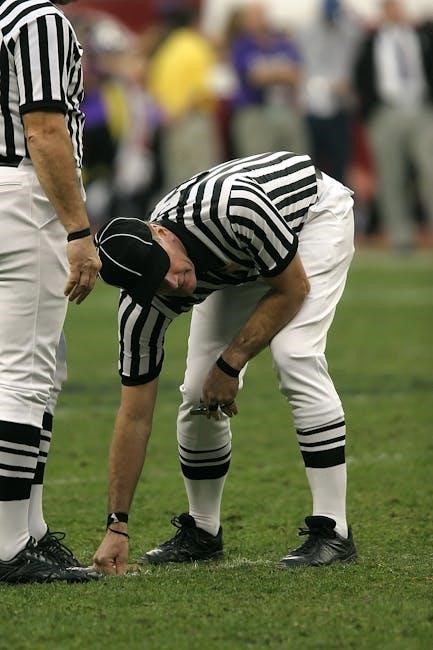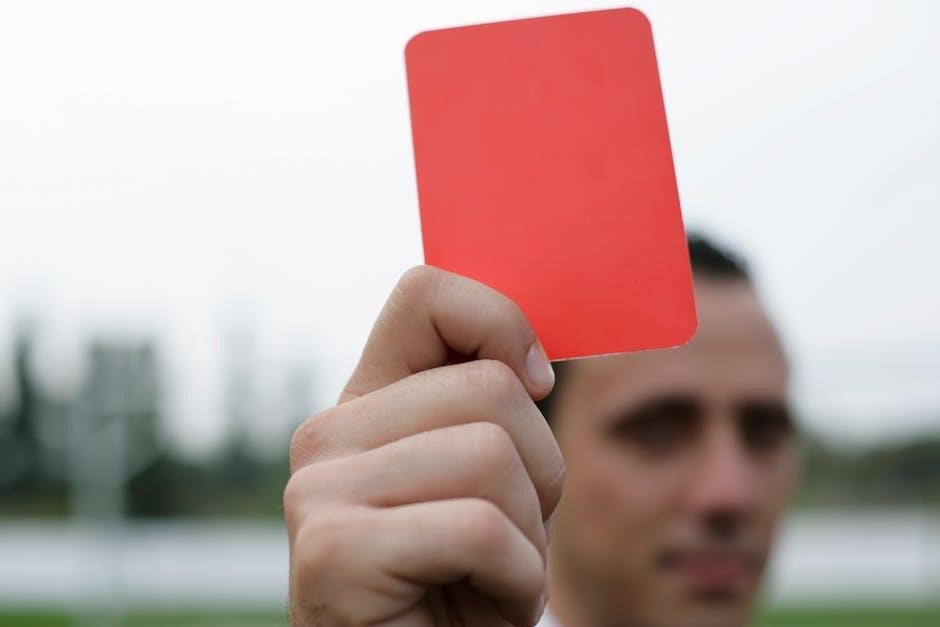
Craps is a popular dice game offering excitement and strategy. Understanding its rules is essential for both new and experienced players to enhance their gaming experience.
1.1 Overview of Craps as a Dice Game
Craps is a dynamic dice game where players bet on outcomes of rolling two dice. A shooter takes turns rolling, aiming for specific numbers. The game features two main phases: the come-out roll and the point phase, with the goal of rolling a 7 or 11 to win or establish a point for further play.
1.2 Importance of Understanding Craps Rules
Understanding craps rules is crucial for maximizing fun and minimizing losses. Knowing the basics, such as pass line bets and point phases, helps players make informed decisions. It also reduces confusion and enhances strategic betting, making the game more enjoyable and potentially profitable for those who take the time to learn its fundamentals thoroughly.

The Come-Out Roll
The Come-Out Roll is the first roll of the dice in a craps game, determining the initial direction of the round. Its outcome sets the stage for potential wins or losses, making it a critical moment in the game.
2.1 Definition and Purpose
The Come-Out Roll is the initial roll of the dice in a craps game, marking the start of a new round. Its purpose is to establish the direction of the game by determining if a Point is set or if the round concludes immediately with a winning or losing outcome.
2.2 Possible Outcomes and Their Implications
The Come-Out Roll can result in a 7 or 11, which are winning outcomes for Pass Line bets. Rolling a 2, 3, or 12 leads to an immediate loss. If a 4, 5, 6, 8, 9, or 10 is rolled, it establishes the Point, transitioning the game to the Point Phase, where the shooter aims to repeat the Point before rolling a 7.
The Pass Line Bet
The Pass Line Bet is placed before the Come-Out Roll. It wins if a 7 or 11 is rolled and loses on 2, 3, or 12.
3.1 What is a Pass Line Bet?
The Pass Line Bet is a fundamental wager in craps, placed on the Pass Line before the Come-Out Roll. It is an even-money bet, meaning it pays 1:1. Players win if the shooter rolls a 7 or 11 on the first roll, making it a popular choice for beginners and experienced players alike.
3.2 How to Place a Pass Line Bet
To place a Pass Line Bet, locate the Pass Line area on the craps table. Place your chips directly on this section before the Come-Out Roll. Ensure your bet is within the table limits and adheres to any minimum betting requirements. This bet is made before the shooter rolls the dice, making it a straightforward wager.
3.3 Payouts and Loss Conditions
The Pass Line Bet pays even money (1:1) if the shooter rolls a 7 or 11 on the Come-Out Roll. If a 2, 3, or 12 is rolled, the bet loses immediately. If a 4, 5, 6, 8, 9, or 10 is rolled, the bet enters the Point Phase, where it can win if the point is made before a 7 is rolled.

The Point Phase
The Point Phase begins if the shooter rolls a 4, 5, 6, 8, 9, or 10 on the Come-Out Roll. The goal is to roll this number again before rolling a 7.
4.1 Establishing the Point
The Point is established when the shooter rolls a 4, 5, 6, 8, 9, or 10 on the Come-Out Roll. The dealer marks this number with a marker, and the shooter aims to roll it again before rolling a 7 to win Pass Line bets. If a 7 comes first, the shooter loses.
4.2 Making the Point
Making the Point occurs when the shooter rolls the established Point number before rolling a 7. Pass Line bets win even money, and the round concludes. The shooter retains the dice, and a new round may begin, offering the opportunity to set a new Point and continue play.
4.3 Missing the Point
Missing the Point occurs when the shooter rolls a 7 before rolling the established Point number. This results in an immediate loss for Pass Line bets. The round ends, and the shooter’s turn concludes. A new shooter is then designated to start a fresh round, resetting the game cycle.

Additional Bets in Craps
Additional bets in craps include various options like Don’t Pass, Come, Don’t Come, and Place Bets, offering players more strategic depth and excitement during gameplay.
5.1 Don’t Pass Bet
The Don’t Pass Bet is a wager placed against the shooter, opposing the Pass Line Bet. It wins if the shooter rolls a 2 or 3 on the come-out roll and loses on a 7 or 11. If a 12 is rolled, it’s typically a push, returning the player’s bet. This bet is popular among players who prefer a more conservative approach, as it has a lower house edge compared to other bets in craps. Understanding the Don’t Pass Bet is crucial for developing a well-rounded strategy at the craps table.
5.2 Come and Don’t Come Bets
The Come Bet is similar to the Pass Line Bet but can be placed after the point is established. It wins on a roll of 7 or 11 and loses on 2, 3, or 12. The Don’t Come Bet is its opposite, winning on 2 or 3 and losing on 7 or 11. These bets offer flexibility, allowing players to engage in the action even after the initial come-out roll, making them strategic options for managing gameplay and potential winnings. They are particularly useful for players looking to diversify their bets during the point phase of the game.
5.3 Place Bets
Place Bets allow players to wager on specific numbers: 4, 5, 6, 8, 9, or 10. These bets are active during the point phase and win if the chosen number rolls before a 7. Payouts vary, with higher numbers offering lower odds. Strategy involves selecting numbers with favorable probabilities, enhancing player control over their wagers and potential returns during gameplay.

Understanding the Craps Table Layout
The craps table layout features two identical sides, each with marked betting areas. These areas correspond to specific bets, such as the Pass Line, Don’t Pass, and Place bets, guiding players on where to place their wagers during the game.
6.1 Key Components of the Table
The craps table layout includes the Pass Line, Don’t Pass, Come, Don’t Come, and Place Bet areas. These are the primary betting zones. The table also features specific sections for Proposition Bets, such as Any Craps, Horn Bets, and Hardways, which cater to various betting strategies and preferences among players.
6.2 Betting Areas and Their Meanings
The craps table features distinct betting areas, each with specific rules. The Pass Line is for wagers on the shooter winning, while Don’t Pass bets on the opposite. Come and Don’t Come mimic Pass/Don’t Pass but after a point is set. Place Bets allow wagering on specific numbers, and Proposition Bets cover unique outcomes like Any Craps or Horn Bets.
Craps Math and Probability
Craps math revolves around dice probabilities, with 36 possible outcomes. Understanding these probabilities helps players make informed decisions and minimize the house edge in various bets.
7.1 Basic Probability Concepts
Craps probabilities are based on two dice, each with six faces, resulting in 36 possible outcomes. Each outcome has a 1/36 chance. The most common roll is 7, occurring in six ways, while 2 and 12 occur once. Understanding these probabilities helps players assess risks and make informed betting decisions, crucial for strategic play.
7.2 House Edge and Odds
The house edge in craps varies by bet, with Pass Line and Don’t Pass offering the lowest at around 1.4%. Other bets, like Any Craps or Horn, have higher edges. Understanding odds is crucial for minimizing losses and maximizing wins, as certain bets provide better value than others in the long run.
Basic Strategy for Playing Craps
A solid craps strategy involves managing your bankroll, starting with simple bets like Pass Line, and avoiding high-house-edge options to maximize your chances of winning.
8.1 Managing Your Bankroll
Effective bankroll management is crucial in craps. Set a budget, stick to it, and avoid chasing losses. Divide your funds into sessions to ensure longevity. Betting within your means helps maintain a positive experience and reduces financial stress, allowing you to enjoy the game responsibly and strategically.
8.2 Starting with Simple Bets
New players should begin with straightforward bets like the Pass Line or Don’t Pass. These wagers offer a low house edge and are easy to follow. Focusing on these bets helps build familiarity with the game’s flow and reduces confusion, making the learning process more enjoyable and effective.
8.3 Avoiding High-House Edge Bets
High-house edge bets, such as the Any Craps or Horn bets, should be avoided due to their low probability of winning. These bets often have a higher risk and lower return, making them less favorable for players. Focusing on simpler, low-edge bets like the Pass Line or Place bets improves your chances of winning and managing your bankroll effectively.

Special Bets and Their Rules
Special bets in craps include Any Craps, Horn Bet, and Hardways Bets. These bets offer unique payouts but come with higher risks. Understanding their rules is crucial.
9.1 Any Craps Bet
The Any Craps bet wagers that the shooter rolls a 2, 3, or 12. If successful, it pays 7:1. It is a one-roll bet, losing on any other number. This bet is popular for its simplicity but carries a higher house edge. Players should use it sparingly as part of their strategy.
9.2 Horn Bet
The Horn Bet is a one-roll wager that combines bets on 2, 3, 11, and 12. It requires a minimum 4-unit bet, with each number receiving an equal portion. If any of these numbers roll, the bet wins, paying 15:1 for 3 or 11, and 30:1 for 2 or 12. It’s popular for its high-payout potential but carries a higher house edge.
9.3 Hardways Bets
A Hardways Bet wagers that a specific pair (2-2, 3-3, 4-4, or 5-5) will roll before a 7 or the opposite pair. Payouts vary: 7:1 for 2-2 or 5-5, and 9:1 for 3-3 or 4-4. These bets remain active until resolved, offering high-risk, high-reward opportunities for experienced players willing to take on the odds and understand the associated risks.

Advanced Strategies and Tips
Advanced players employ hedge betting, pressing winning bets strategically, and learning from experienced players to optimize their gameplay and minimize risks at the craps table effectively.
10.1 Hedge Betting
Hedge betting in craps involves placing complementary wagers to offset potential losses. By strategically combining bets like pass line with don’t pass, players can balance risk and reward, ensuring a safer approach during unpredictable dice rolls. This method is favored by experienced players to maintain bankroll stability and extend gameplay opportunities effectively always.
10.2 Pressing Your Bets
Pressing your bets in craps involves increasing your wagers after winning rolls to capitalize on a hot streak. This strategy aims to maximize profits during favorable moments. However, it requires discipline, as losses can escalate quickly if luck turns. Knowing when to press and when to hold is crucial for long-term success at the table.
10.4 Learning from Experienced Players
Observing and learning from seasoned players can enhance your craps strategy. Experienced players often demonstrate effective bankroll management, bet placement, and emotional control. By studying their decisions and adaptability, you can gain insights into optimizing your gameplay and minimizing risks. This practical knowledge complements theoretical understanding, helping you refine your approach over time.
